Breast Geometry Characterization of Young American Females Using 3D Image Analysis
Abstract
:1. Introduction
2. Materials and Methods
2.1. Body Scan Data
2.2. 3D Image Analysis
2.3. Statistical Analysis
3. Result and Discussion
3.1. Breast Shape Analysis
3.2. Breast Placement Analysis
3.3. Shape and Placement Relationship
4. Conclusions
Author Contributions
Funding
Data Availability Statement
Conflicts of Interest
References
- Bistoni, G.; Farhadi, J. Anatomy and physiology of the breast. In Plastic and Reconstructive Surgery Approaches and Techniques; Farhadieh, R., Bulstrode, N., Cugno, S., Eds.; Wiley: Blackwell, NJ, USA, 2015; pp. 479–485. [Google Scholar]
- McGhee, D.E.; Steele, J.R. Breast biomechanics: What do we really know? Physiology 2020, 35, 144–156. [Google Scholar] [CrossRef] [PubMed]
- Mayo Clinic. Female Breast Anatomy. Mayo Foundation for Medical Education and Research. Available online: https://www.mayoclinic.org/healthy-lifestyle/womens-health/multimedia/breast-cancer-early-stage/sls-20076628 (accessed on 13 November 2020).
- Sohn, B.H. A study on breast type classification & discrimination using manual measurement-focusing on Korean women in their 20s. J. Korea Soc. Comput. Inf. 2020, 25, 137–146. [Google Scholar]
- Coltman, C.E.; Steele, J.R.; McGhee, D.E. Effects of age and body mass index on breast characteristics: A cluster analysis. Ergonomics 2018, 61, 1232–1245. [Google Scholar] [CrossRef]
- Coltman, C.E.; Brisbine, B.R.; Steele, J.R. Bra-body armour integration, breast discomfort and breast injury associated with wearing body armour. Ergonomics 2021, 64, 1623–1633. [Google Scholar] [CrossRef]
- Gefen, A.; Dilmoney, B. Mechanics of the normal woman’s breast. Technol. Health Care 2007, 15, 259–271. [Google Scholar] [CrossRef]
- Suh, M. Breast size and anthropometric changes through brassieres. J. Text. Appar. Technol. Manag. 2021, 12, 1–15. [Google Scholar]
- Brisbine, B.R.; Steele, J.R.; Phillips, E.J.; McGhee, D.E. Breast pain affects the performance of elite female athletes. J. Sports Sci. 2020, 38, 528–533. [Google Scholar] [CrossRef]
- Pei, J.; Fan, J.; Ashdown, S.P. A novel optimization approach to minimize aggregate-fit-loss for improved breast sizing. Text. Res. J. 2020, 90, 1823–1836. [Google Scholar] [CrossRef]
- Sun, Y.; Yick, K.L.; Cai, Y.; Yu, W.; Chen, L.; Lau, N.; Zhang, S. Finite element analysis on contact pressure and 3D breast deformation for application in women’s bras. Fibers Polym. 2021, 22, 2910–2921. [Google Scholar]
- Pandarum, R.; Yu, W.; Hunter, L. 3-D breast anthropometry of plus-sized women in South Africa. Ergonomics 2011, 54, 866–875. [Google Scholar]
- Brisbine, B.R.; Steele, J.R.; Phillips, E.J.; McGhee, D.E. Breast and torso characteristics of female contact football players: Implications for the design of sports bras and breast protection. Ergonomics 2020, 63, 850–863. [Google Scholar] [CrossRef] [PubMed]
- Catanuto, G.; Taher, W.; Rocco, N.; Catalano, F.; Allegra, D.; Milotta, F.; Stanco, F.; Gallo, G.; Nava, M. Breast shape analysis with curvature estimates and principal component analysis for cosmetic and reconstructive breast surgery. Aesthetic Surg. J. 2019, 39, 164–173. [Google Scholar]
- Hsia, H.; Thomson, J. Differences in breast shape preferences between plastic surgeons and patients seeking breast augmentation. Cosmetic 2003, 122, 312–320. [Google Scholar] [CrossRef] [PubMed]
- Tepper, O.; Unger, J.; Small, K.; Feldman, D.; Kumar, N.; Choi, M.; Karp, N. Mammometrics: The standardization of aesthetic and reconstructive breast surgery. Plast. Reconstr. Surg. 2010, 125, 393–400. [Google Scholar] [CrossRef]
- Penn, J. Breast reduction. Plast. Reconstr. Surg. 1954, 7, 357–371. [Google Scholar] [CrossRef]
- Eisenmann-Klein, M. Breast reduction and mastopexy. In Plastic and Reconstructive Surgery; Siemionow, M., Eisenmann-Klein, M., Eds.; Springer Specialist Surgery Series; Springer: London, UK, 2010; pp. 49–53. [Google Scholar]
- Brown, N.; White, J.; Milligan, A.; Risiu, D.; Ayers, B.; Hedger, W.; Scurr, J. The relationship between breast size and anthropometric characteristics. Am. J. Hum. Biol. 2012, 24, 158–164. [Google Scholar] [CrossRef]
- Charles-de-Sá, L.; de Aguiar Valladão, T.; Vieira, D.M.L.; Aboudib, J.H. Anthropometric aspects in the breast augmentation. Aesthetic Plast. Surg. 2020, 44, 1498–1507. [Google Scholar] [CrossRef]
- Heine, N.; Eisenmann-Klein, M.; Prantl, L. Gigantomasty: Treatment with a short vertical scar. Aesthetic Plast. Surg. 2008, 32, 41–47. [Google Scholar] [CrossRef]
- Joseph-Armstrong, H. Patternmaking for Fashion Design; Prentice Hall: Upper Saddle River, NJ, USA, 2010. [Google Scholar]
- Cho, S.H.; Kim, M.S. Brassiere pattern development based on 3D measurements of upper body—Focused on women in their 30’s. Res. J. Costume Cult. 2008, 16, 488–501. [Google Scholar]
- Cho, S.H.; Kim, M.S. Brassiere pattern development based on 3D measurements of upper body for women in their 40’s. Res. J. Costume Cult. 2008, 16, 502–517. [Google Scholar]
- Cha, S. The uplifting effect of a prototype brassiere. Int. J. Cloth. Sci. Technol. 2012, 24, 154–169. [Google Scholar] [CrossRef]
- Cha, S.; Son, H. Comparison of brassiere pattern according to breast shape on China adult females. J. Fash. Bus. 2011, 15, 63–79. [Google Scholar]
- Hiraoka, T. My Foundation, the Way to Choose Right Underwear; Wacoal Human Science Research Center: Tokyo, Japan, 1990. [Google Scholar]
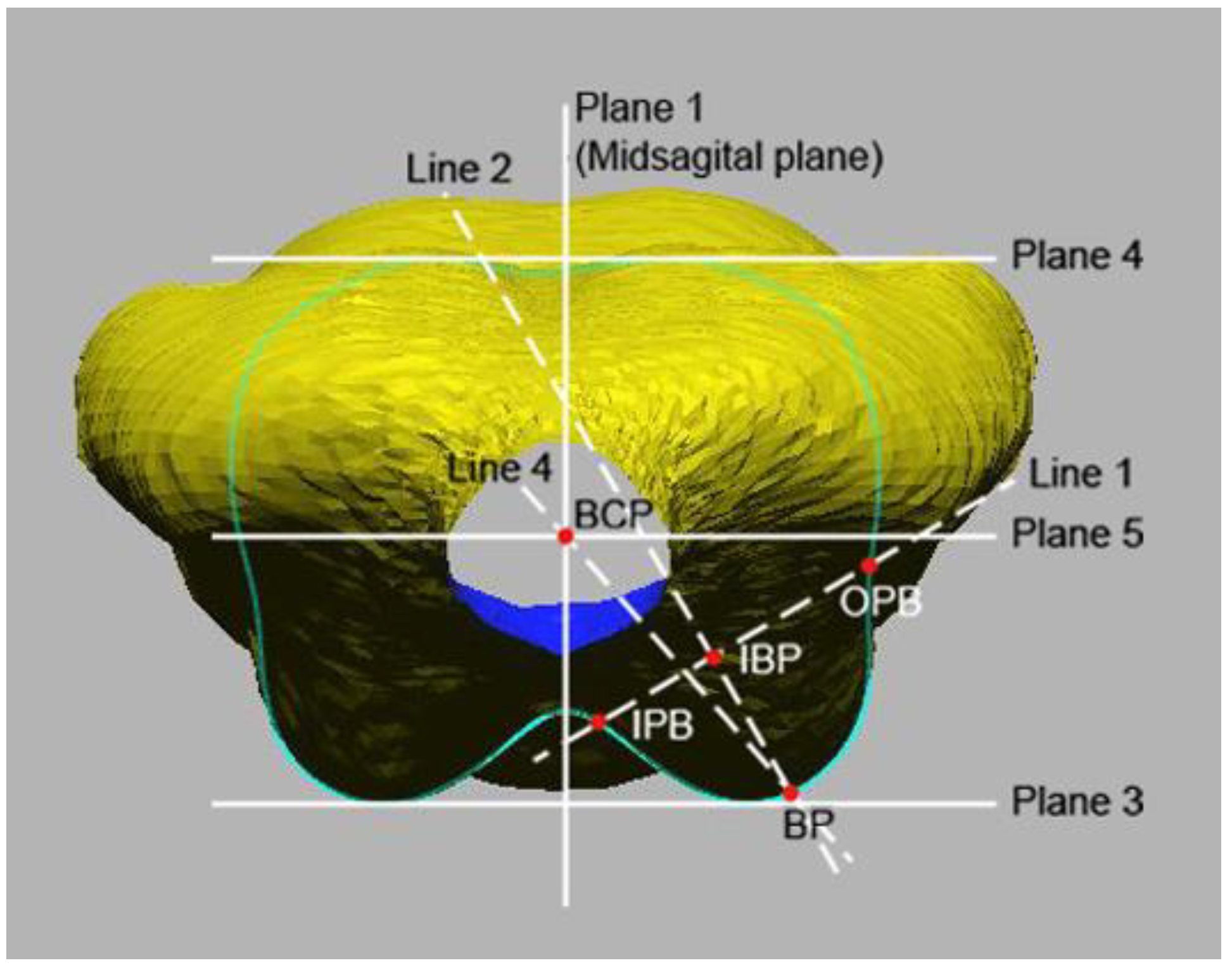
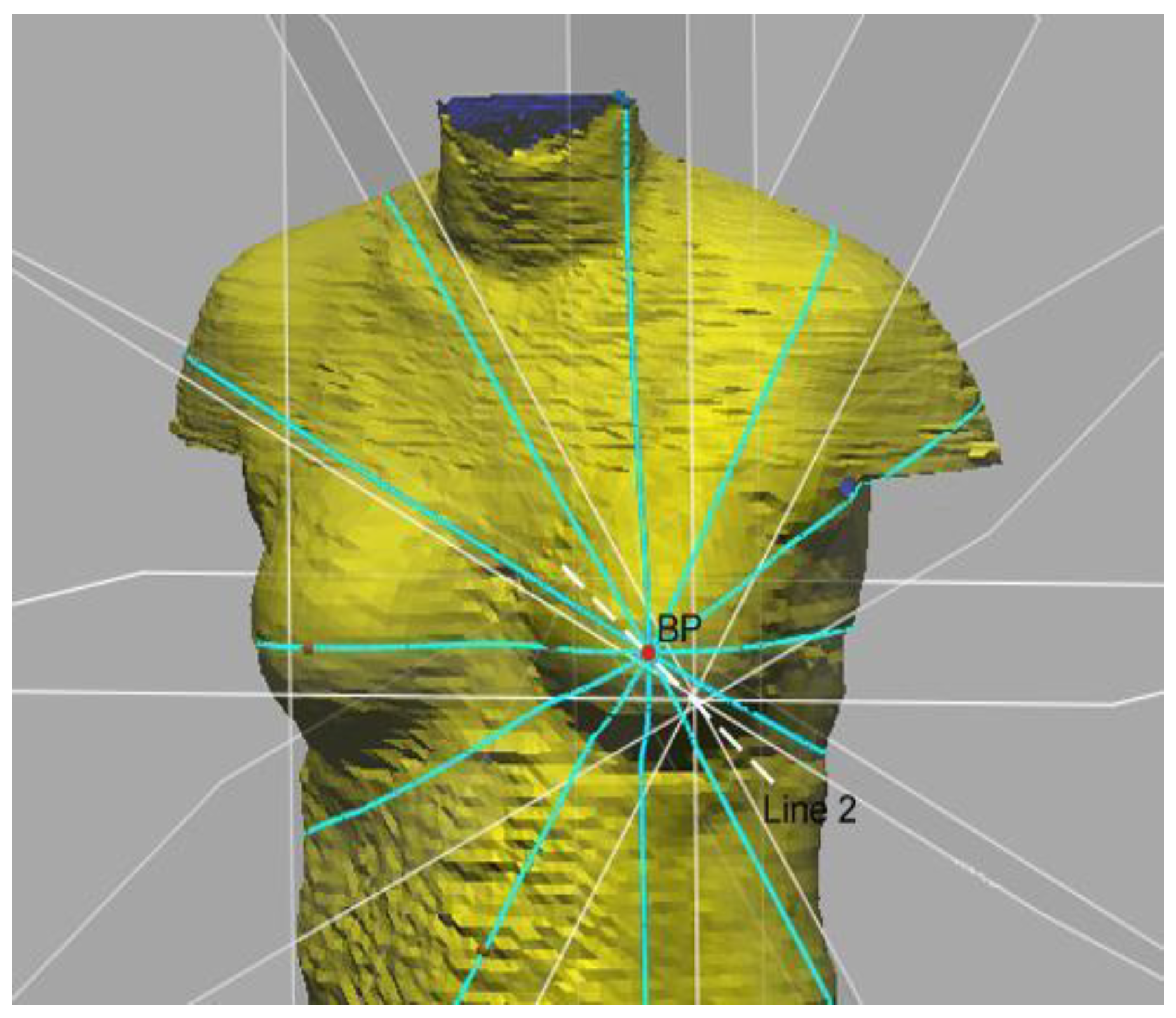
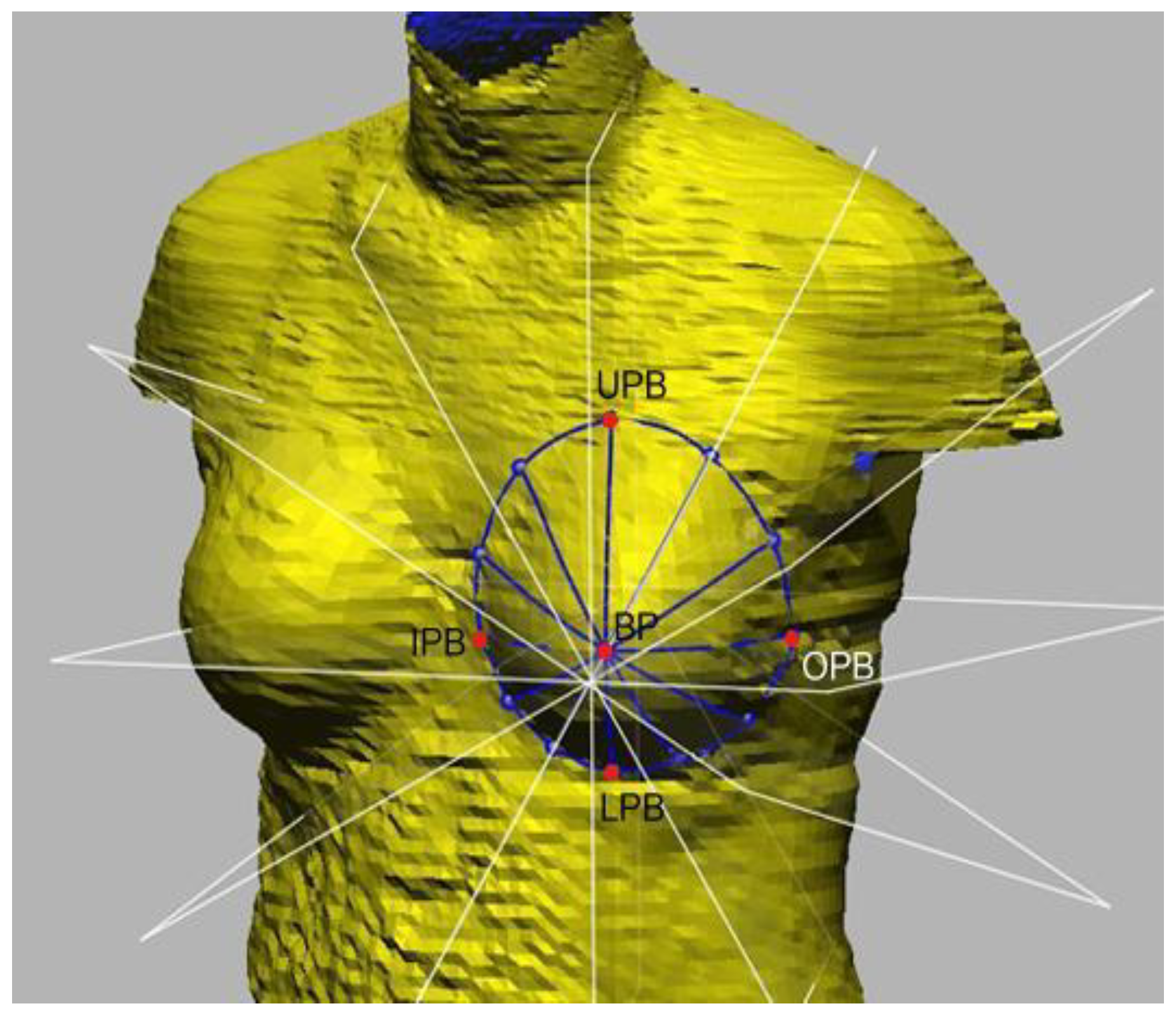
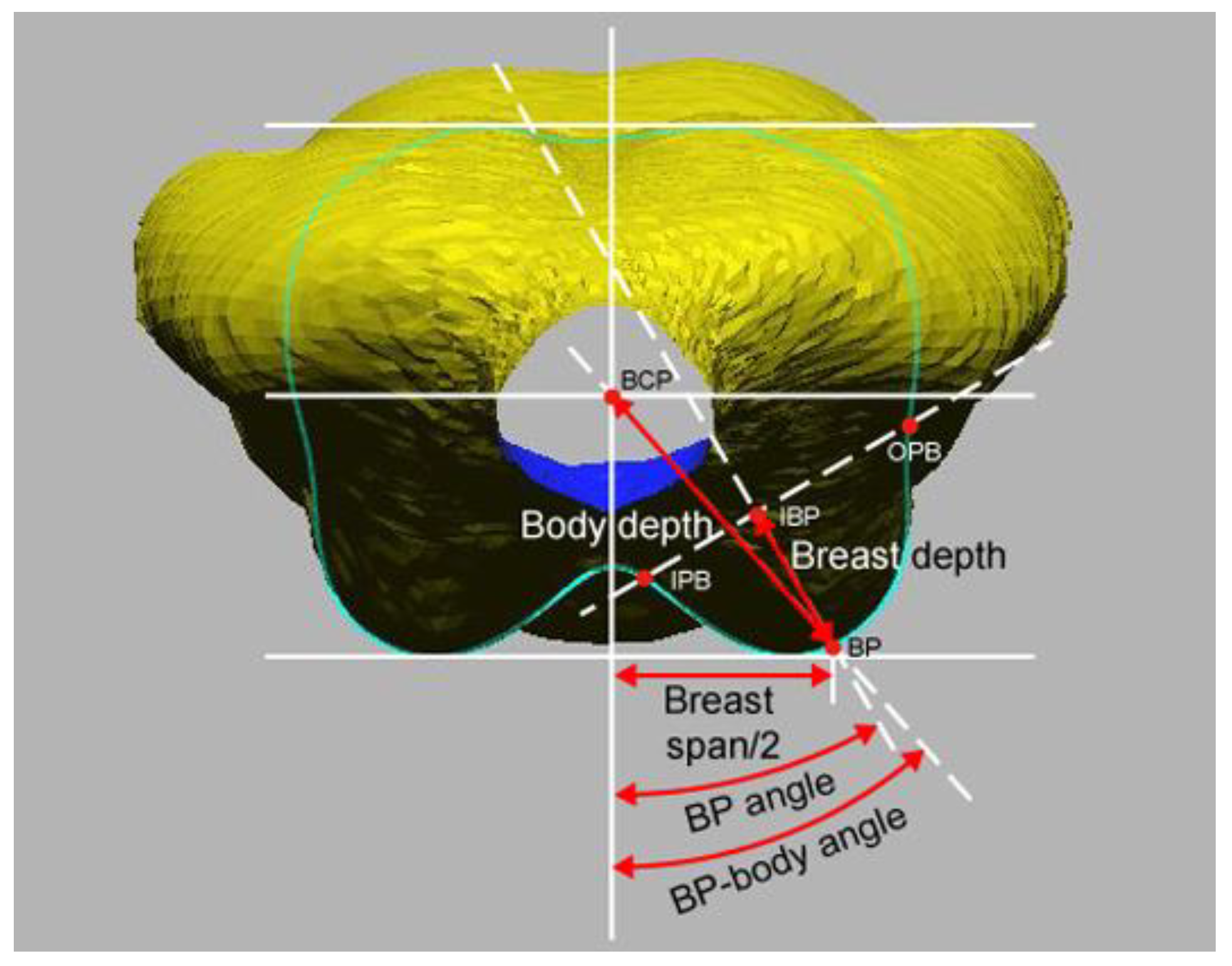
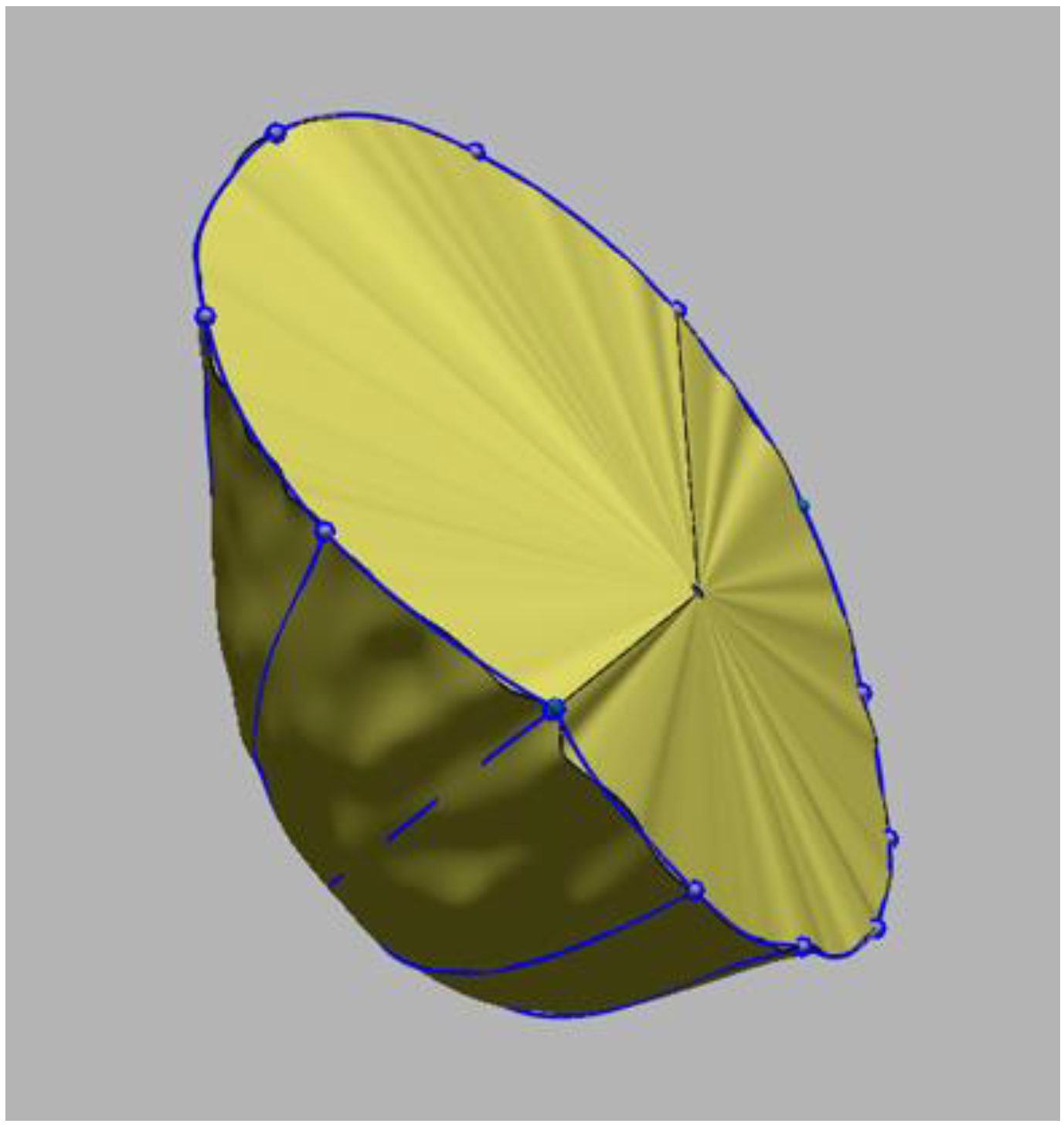
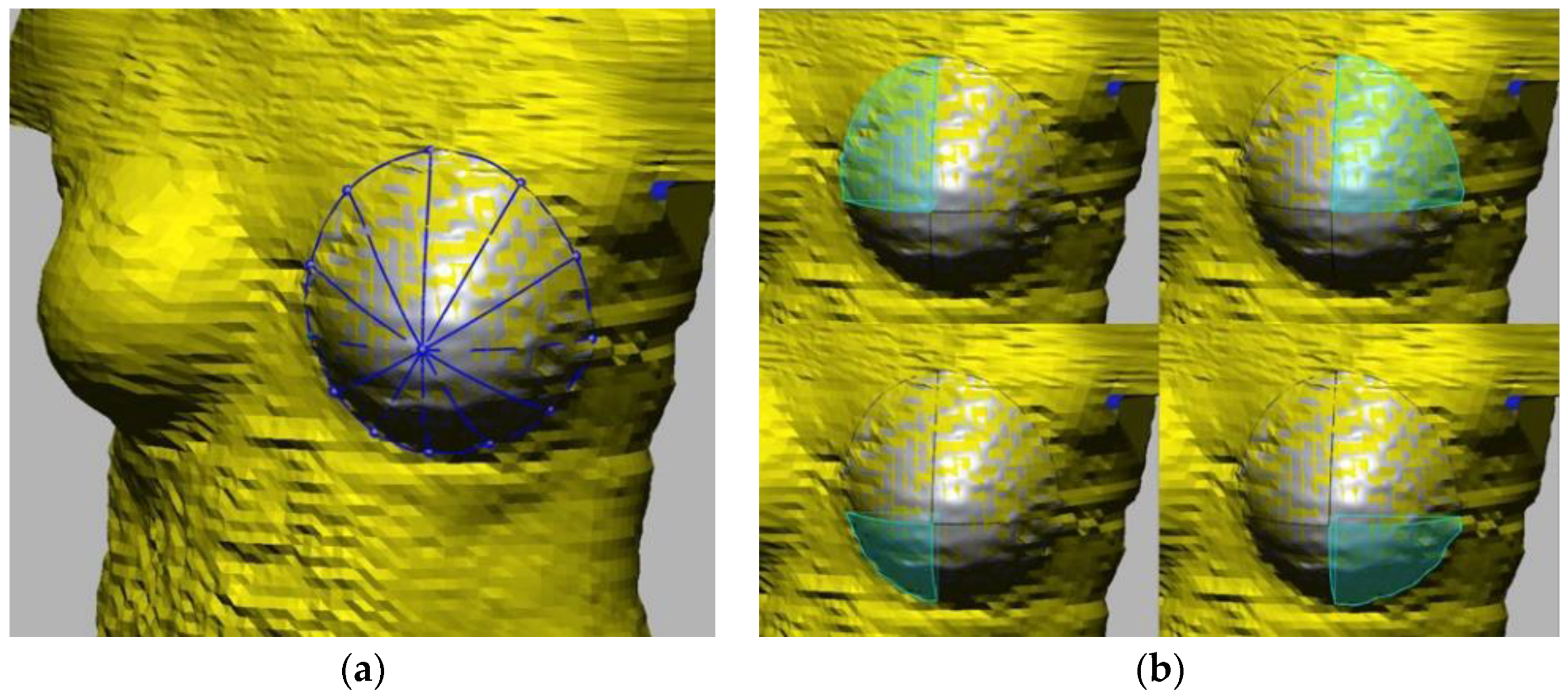
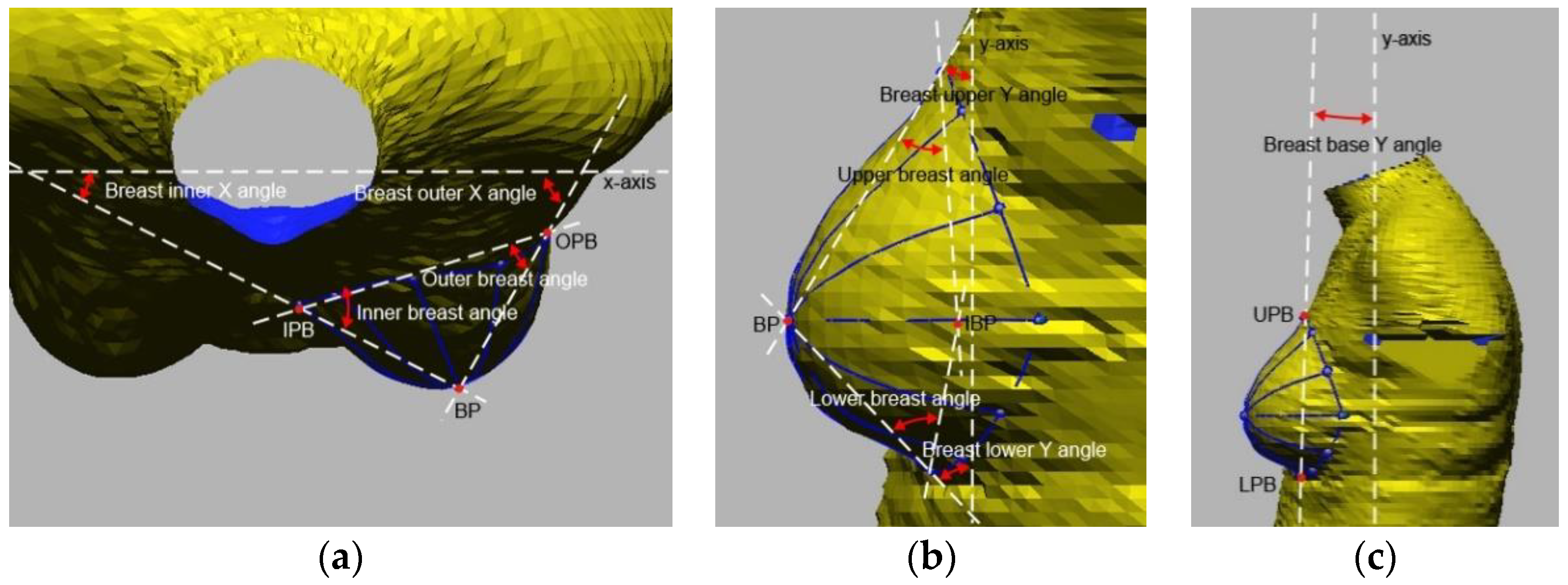
| Subjects (Age) | Measurements Considered | Breast Shape Clusters | Prevalence | |
|---|---|---|---|---|
| [4] | 182 Korean females (20–25) | breast girth breast volume | (1) spheric | 14% |
| (2) flat | 41% | |||
| (3) drooped | 34% | |||
| (4) protruded | 11% | |||
| [23] | 174 Korean females (30–39) | 45 types of breast lengths 5 types of breast angles body weight | (1) drooped | 29% |
| (2) spheric | 28% | |||
| (3) protruded | 22% | |||
| (4) flat | 20% | |||
| [24] | 83 Korean females (40–49) | 45 types of breast lengths 5 types of breast angles body weight | (1) drooped | 34% |
| (2) spheric | 31% | |||
| (3) protruded | 19% | |||
| (4) flat | 16% | |||
| [25] | 208 Chinese females (18–24) | 34 types of lengths 4 types of angles height and weight | (1) dome-shaped | 35% |
| (2) cone-shaped | 28% | |||
| (3) flat | 28% | |||
| (4) protruded | 19% | |||
| [5] | 345 Australian females (18–84) | breast volume breast surface area sternal notch-nipple length underbust girth | (1) extra-large, very ptotic | 12% |
| (2) large, ptotic | 28% | |||
| (3) medium, mildly ptotic | 34% | |||
| (4) small, not ptotic | 26% |
| 678 White Females | 298 White Females | 156 White Females | ||||
|---|---|---|---|---|---|---|
| Mean | st.dev. | Mean | st.dev. | Mean | st.dev. | |
| height (cm) | 164.70 | ±6.54 | 164.57 | ±6.34 | 162.93 | ±5.56 |
| weight (kg) | 70.01 | ±18.15 | 66.37 | ±8.38 | 65.56 | ±7.87 |
| bust girth (cm) | 101.88 | ±13.08 | 99.80 | ±6.02 | 99.23 | ±5.93 |
| waist girth (cm) | 85.12 | ±14.01 | 82.35 | ±6.38 | 82.40 | ±6.16 |
| upper body length (cm) | 40.24 | ±2.79 | 40.21 | ±1.46 | 40.17 | ±1.49 |
| Reference Point | Abbr. | Description |
|---|---|---|
| Bust point | BP | Most prominent point on the breast cup |
| Inner bust point | IBP | BP projected on breast base |
| Body center point | BCP | Midpoint sagittally and transversely defined at BP level |
| Upper point of breast | UPB | Superior-most point on the breast boundary |
| Lower point of breast | LPB | Inferior-most point on the breast boundary |
| Inner point of breast | IPB | Medial-most point on the breast boundary |
| Outer point of breast | OPB | Lateral-most point on the breast boundary |
| Measurement | Unit | Shape 1 | Placement 2 | |
|---|---|---|---|---|
| Contour length | Upper breast arc | mm | ✓ | |
| Lower breast arc | mm | ✓ | ||
| Inner breast arc | mm | ✓ | ||
| Outer breast arc | mm | ✓ | ||
| Breast root | mm | ✓ | ||
| Linear length | Upper breast height | mm | ✓ | |
| Lower breast height | mm | ✓ | ||
| Lower-upper height ratio 3 | % | ✓ | ||
| Inner breast width | mm | ✓ | ||
| Outer breast width | mm | ✓ | ||
| Inner-outer width ratio 3 | % | ✓ | ||
| Width-height ratio 3 | % | ✓ | ||
| Breast depth | mm | ✓ | ✓ | |
| Body depth | mm | ✓ | ||
| Breast-body depth ratio 3 | % | ✓ | ||
| Breast span half | mm | ✓ | ✓ | |
| Shoulder distance | Mid-shoulder to BP % | % | ✓ | |
| Shoulder-neck to BP % | % | ✓ | ||
| Shoulder tip to BP % | % | ✓ | ||
| Front neck to BP % | % | ✓ | ||
| Angle | BP angle | ° | ✓ | |
| BP-body angle | ° | ✓ | ||
| Upper breast angle | ° | ✓ | ||
| Lower breast angle | ° | ✓ | ||
| Inner breast angle | ° | ✓ | ||
| Outer breast angle | ° | ✓ | ||
| Breast base Y angle | ° | ✓ | ||
| Upper breast Y angle | ° | ✓ | ||
| Lower breast Y angle | ° | ✓ | ||
| Inner breast X angle | ° | ✓ | ||
| Outer breast X angle | ° | ✓ | ||
| Area | Breast surface area | cm2 | ✓ | |
| Breast base area | cm2 | ✓ | ||
| Volume | Total volume | cm3 | ✓ | |
| Upper inner volume % | % | ✓ | ||
| Lower inner volume % | % | ✓ | ||
| Upper outer volume % | % | ✓ | ||
| Lower outer volume % | % | ✓ |
| Component | |||||
|---|---|---|---|---|---|
| 1 | 2 | 3 | 4 | 5 | |
| Breast base area | 0.974 | 0.154 | |||
| Breast surface area | 0.969 | 0.191 | |||
| Total volume | 0.948 | 0.227 | 0.116 | ||
| Inner breast arc | 0.901 | −0.197 | 0.130 | 0.330 | |
| Upper breast arc | 0.876 | −0.282 | −0.266 | ||
| Breast root | 0.869 | 0.160 | 0.399 | 0.110 | |
| Breast depth | 0.817 | 0.262 | 0.499 | ||
| Outer breast arc | 0.802 | 0.543 | 0.168 | 0.120 | |
| Upper breast height | 0.771 | −0.442 | −0.395 | ||
| Breast span half | 0.768 | −0.209 | 0.137 | 0.301 | |
| Lower breast height | 0.740 | 0.126 | 0.602 | −0.158 | −0.111 |
| Lower breast arc | 0.739 | 0.189 | 0.357 | 0.185 | −0.115 |
| Outer breast width | 0.711 | 0.614 | 0.252 | ||
| Inner–outer width ratio | −0.291 | −0.906 | −0.128 | ||
| Upper inner volume % | −0.223 | −0.801 | −0.439 | −0.161 | |
| Inner breast width | 0.568 | −0.732 | 0.141 | −0.107 | 0.147 |
| Upper outer volume % | 0.664 | −0.628 | −0.136 | ||
| Inner breast angle | 0.402 | 0.664 | 0.540 | ||
| Lower outer volume % | 0.405 | 0.601 | 0.564 | ||
| Lower–upper height ratio | 0.924 | 0.220 | |||
| Lower volume % | 0.246 | 0.154 | 0.916 | 0.107 | |
| Lower inner volume % | −0.147 | −0.541 | 0.707 | 0.114 | |
| Outer breast angle | −0.455 | 0.769 | −0.366 | ||
| Upper breast angle | 0.234 | 0.457 | 0.738 | 0.314 | |
| Lower breast angle | 0.147 | −0.547 | 0.738 | 0.210 | |
| Width–height ratio | 0.165 | 0.192 | 0.923 | ||
| Shape Clusters and Cluster Averages | Scheffe’s Post-Hoc Analysis | ||||
|---|---|---|---|---|---|
| Cluster 1 a | Cluster 2 b | Cluster 3 c | Cluster 4 d | ||
| (n = 48) | (n = 30) | (n = 37) | (n = 41) | ||
| Upper breast arc (mm) | 116.3460 | 100.3637 | 105.6795 | 127.4434 | b, c < a < d |
| Lower breast arc (mm) | 79.4454 | 66.6640 | 82.5611 | 94.7085 | b < a, c < d |
| Inner breast arc (mm) | 91.6142 | 81.2780 | 96.5486 | 101.3263 | b < a < c < d |
| Outer breast arc (mm) | 99.7227 | 93.0010 | 102.3122 | 125.6661 | b, a, c < d |
| Breast root (mm) | 197.2569 | 189.9823 | 208.9854 | 231.2951 | b, a, c < d |
| Upper breast height (mm) | 94.5294 | 81.3400 | 83.3943 | 98.4932 | b, c < a, d |
| Lower breast height (mm) | 57.0458 | 53.3717 | 60.3454 | 66.7968 | b, a, c < d |
| Lower–upper height ratio (%) | 37.65 | 39.67 | 41.97 | 40.41 | a < b, d, c |
| Inner breast width (mm) | 63.5463 | 61.0303 | 67.4278 | 66.2766 | b, a, d, c |
| Outer breast width (mm) | 72.1163 | 73.0947 | 74.0584 | 93.7429 | a, b, c < d |
| Inner–outer width ratio (%) | 46.79 | 45.77 | 47.81 | 41.49 | d < b, a, c |
| Width–height ratio (%) | 89.00 | 99.80 | 99.32 | 97.24 | a < d, c, b |
| Breast depth (mm) | 60.2546 | 50.2940 | 63.2070 | 70.9993 | b < a, c < d |
| Breast span half (mm) | 95.8427 | 94.7063 | 101.9638 | 106.6222 | b, a < c < d |
| Upper breast angle (°) | 32.1817 | 30.9227 | 37.5708 | 34.7388 | b, a < d < c |
| Lower breast angle (°) | 52.4956 | 49.4400 | 52.8938 | 51.7341 | b, d, a, c |
| Inner breast angle (°) | 43.0483 | 39.5593 | 43.0114 | 47.1993 | b < c, a < d |
| Outer breast angle (°) | 39.8942 | 34.5773 | 40.4997 | 36.8285 | b < d < a, c |
| Breast surface area (cm2) | 245.179 | 195.931 | 241.675 | 326.912 | b < c, a < d |
| Breast base area (cm2) | 172.812 | 149.685 | 168.593 | 219.827 | b < c, a < d |
| Total volume (cm3) | 458.367 | 324.552 | 469.893 | 725.836 | b < a, c < d |
| Upper inner volume (%) | 28.63 | 26.87 | 26.81 | 23.00 | d < c, b, a |
| Lower inner volume (%) | 18.04 | 17.83 | 21.43 | 17.20 | d, b, a < c |
| Upper outer volume (%) | 31.13 | 33.17 | 27.11 | 32.20 | c < a, d, b |
| Lower outer volume (%) | 22.42 | 22.27 | 24.73 | 27.66 | b, a < c < d |
| Lower volume (%) | 40.42 | 40.03 | 46.14 | 44.80 | b, a < d, c |
| Component | ||||
|---|---|---|---|---|
| 1 | 2 | 3 | 4 | |
| Mid-shoulder to BP | 0.953 | 0.150 | ||
| Shoulder-neck to BP | 0.945 | 0.181 | ||
| Shoulder tip to BP | 0.907 | 0.125 | ||
| Front neck to BP | 0.894 | 0.188 | ||
| Body depth | 0.751 | 0.265 | 0.210 | 0.208 |
| Breast span half | 0.577 | 0.179 | 0.571 | 0.143 |
| Breast–body depth ratio | 0.197 | 0.910 | 0.143 | |
| Breast depth | 0.525 | 0.787 | 0.219 | 0.129 |
| Inner breast X angle | 0.771 | −0.573 | ||
| Lower breast Y angle | 0.331 | 0.696 | −0.461 | |
| Breast–body depth ratio | 0.197 | 0.910 | 0.143 | |
| BP angle | 0.162 | 0.823 | ||
| Outer breast X angle | 0.130 | 0.409 | 0.812 | |
| BP-body angle | −0.254 | −0.118 | 0.634 | −0.135 |
| Breast base Y angle | −0.256 | −0.171 | 0.906 | |
| Upper breast Y angle | 0.301 | 0.265 | 0.867 | |
| Placement Clusters and Cluster Averages | Scheffe’s Post-Hoc Analysis | |||
|---|---|---|---|---|
| Cluster 3 a | Cluster 1 b | Cluster 2 c | ||
| (n = 56) | (n = 68) | (n = 32) | ||
| Mid-shoulder to BP (%) | 53.3071 | 56.4885 | 61.0803 | a < b < c |
| Shoulder-neck to BP (%) | 62.9277 | 66.4513 | 71.1484 | a < b < c |
| Shoulder tip to BP (%) | 56.7086 | 60.6434 | 65.0497 | a < b < c |
| Front neck to BP (%) | 57.6098 | 60.9834 | 64.7953 | a < b < c |
| Breast depth (mm) | 53.3380 | 63.1685 | 74.0087 | a < b < c |
| Body depth (mm) | 150.9157 | 162.9482 | 179.4178 | a < b < c |
| Breast–body depth ratio (%) | 35.3807 | 38.8312 | 41.2641 | a < b < c |
| Breast span half (mm) | 93.5386 | 99.9116 | 111.0519 | a < b < c |
| BP angle (°) | 23.8400 | 23.0169 | 36.9816 | b, a < c |
| BP-body angle (°) | 38.6362 | 37.8900 | 38.2584 | a, b, c |
| Breast base Y angle (°) | 5.9063 | 5.6385 | 5.6125 | a, b, c |
| Upper breast Y angle (°) | 32.6212 | 35.4322 | 38.5525 | a < b < c |
| Lower breast Y angle (°) | 34.9413 | 39.2759 | 41.4175 | a < b, c |
| Inner breast X angle (°) | 17.1580 | 19.9809 | 20.8213 | a < b, c |
| Outer breast X angle (°) | 61.0893 | 61.9385 | 65.3587 | a, b < c |
| Value | df | Asymptotic Significance (2-Sided) | |
|---|---|---|---|
| Pearson Chi-square | 102.739 | 6 | 0.000 |
| Likelihood ratio | 118.226 | 6 | 0.000 |
| Linear-by-linear association | 6.933 | 1 | 0.008 |
| N of valid cases | 156 |
| Placement Clusters | Total | |||||
|---|---|---|---|---|---|---|
| 3 | 1 | 2 | ||||
| (High) | (Medium) | (Low/Open) | ||||
| Shape clusters | 1 | count | 21 (43.8%) | 27 (56.3%) | 0 (0.0%) | 48 (30.8%) |
| (drooped) | χ2 | 1.9 (p = 0.1615) | 4.5 (p = 0.0357) | 17.9 (p = 0.0000) | ||
| 2 | count | 27 (90.0%) | 3 (10.0%) | 0 (0.0%) | 30 (19.2%) | |
| (small/flat) | χ2 | 6.9 (p = 0.0000) | 17.0 (p = 0.0000) | 0.49 (p = 0.0000) | ||
| 3 | count | 8 (21.6%) | 22 (59.5%) | 7 (18.9%) | 37 (23.7%) | |
| (upward) | χ2 | 4.3 (p = 0.0357) | 5.0 (p = 0.0278) | 0.1 (p = 0.7642) | ||
| 4 | count | 0 (0.0%) | 16 (39.0%) | 25 (61.0%) | 41 (26.3%) | |
| (large) | χ2 | 31.1 (p = 0.0000) | 0.5 (p = 0.4839) | 55.8 (p = 0.0000) | ||
| Total | 56 (35.9%) | 68 (43.6%) | 32 (20.5%) | 156 (100%) | ||
Publisher’s Note: MDPI stays neutral with regard to jurisdictional claims in published maps and institutional affiliations. |
© 2022 by the authors. Licensee MDPI, Basel, Switzerland. This article is an open access article distributed under the terms and conditions of the Creative Commons Attribution (CC BY) license (https://creativecommons.org/licenses/by/4.0/).
Share and Cite
Suh, M.; Park, J.H. Breast Geometry Characterization of Young American Females Using 3D Image Analysis. Appl. Sci. 2022, 12, 8578. https://doi.org/10.3390/app12178578
Suh M, Park JH. Breast Geometry Characterization of Young American Females Using 3D Image Analysis. Applied Sciences. 2022; 12(17):8578. https://doi.org/10.3390/app12178578
Chicago/Turabian StyleSuh, Minyoung, and Jung Hyun Park. 2022. "Breast Geometry Characterization of Young American Females Using 3D Image Analysis" Applied Sciences 12, no. 17: 8578. https://doi.org/10.3390/app12178578
APA StyleSuh, M., & Park, J. H. (2022). Breast Geometry Characterization of Young American Females Using 3D Image Analysis. Applied Sciences, 12(17), 8578. https://doi.org/10.3390/app12178578




